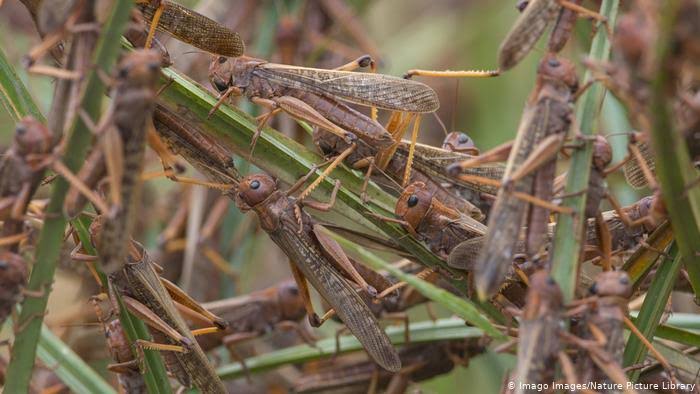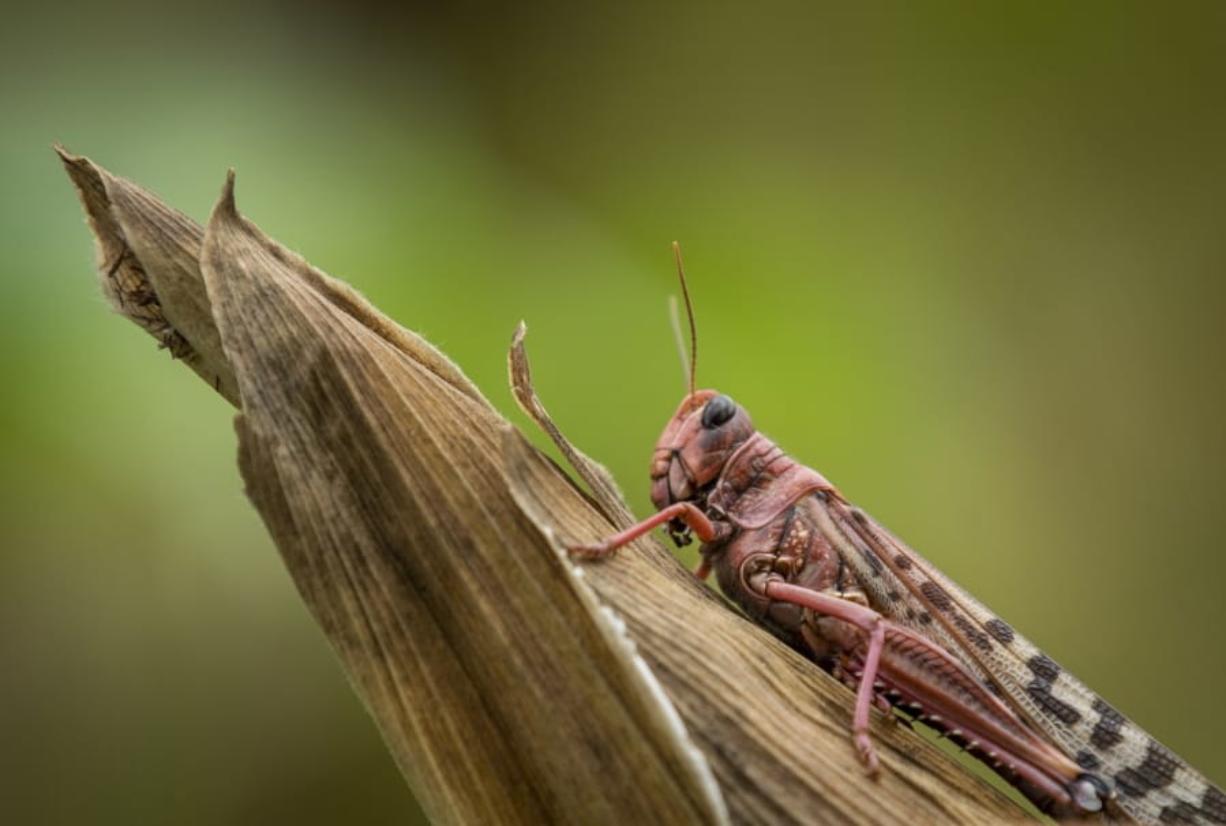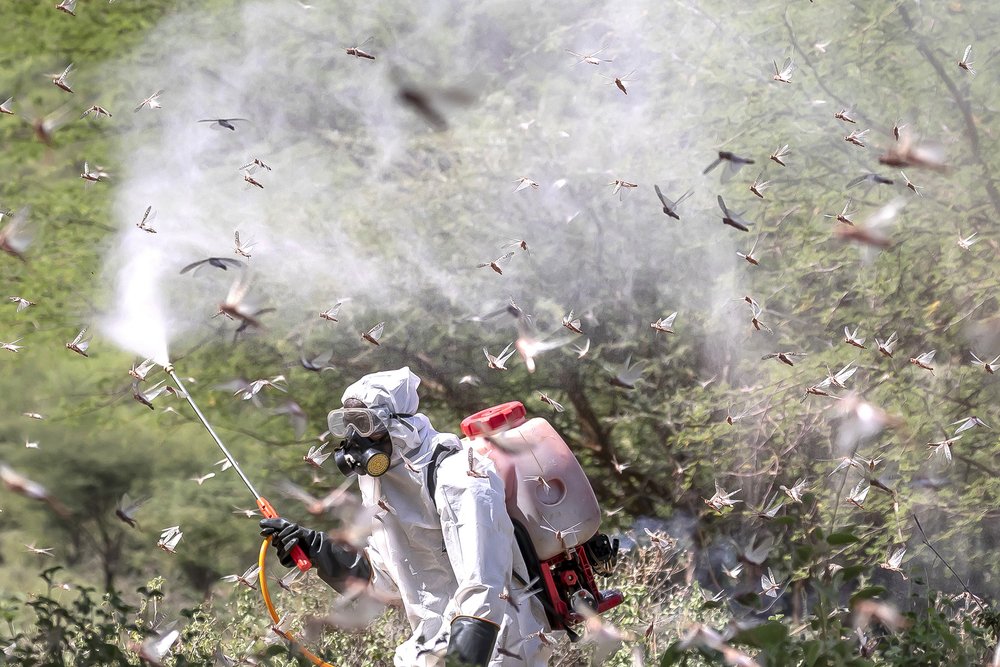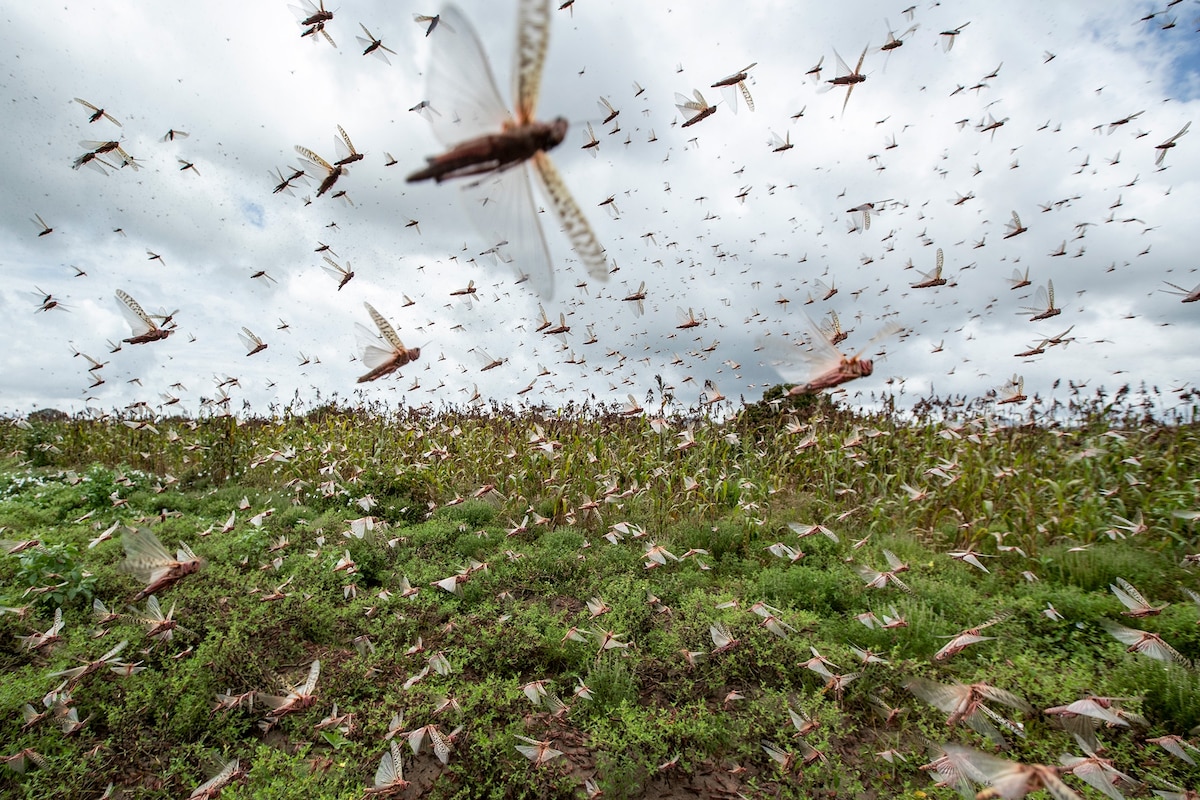From time immemorial, including biblical history, locusts have been mentioned as agricultural enemies of humans. These insects are known to move in swarms minacious enough to cover hundreds of acres of land, just like they were said to have covered up the whole of Egypt in biblical history. Locusts have always been familiar but unwanted visitors in the African continent. Although harmless to human beings (they don’t attack humans), Locusts in Africa have always been a source of concern, especially the current locust invasion.
Locusts are actually a type of short-horned grasshoppers that have a phase when they Swarm, causing havoc to crops and devastation to farm produce, leading to; Poor harvests, food shortage, and famine. Though they do not cause any inherent issues like diseases in humans, locust invasions have caused famine and migration. The most common type of locust infestation is desert locust infestation.
What triggers a locust invasion?
Locusts are usually solitary with low numbers that normally pose no threats. However, in the event of a long drought and then unprecedented rainfalls that lead to rapid vegetation growth, the serotonin in their brains triggers a set of very dramatic changes in their system, which causes them to breed rapidly and abundantly. When their population becomes too dense as a result of the rapid breeding, they become migratory.
These locusts then form bands of wingless nymphs, which later metamorphose into Swarms of winged adults. These winged adults are great fliers that can travel great distances, covering up large areas of land and sky and wreaking havoc on green vegetation and crops. Whilst the wingless nymphs hop around vegetation and feed on crops.
Locusts In Africa
This has been the occurrence in certain parts of Africa that have been witnessing locust invasion. The African countries that have witnessed invasions in recent times are Eritrea, Somalia, Kenya, Ethiopia, Uganda and Tanzania, Djibouti, Burundi, with Kenya and Ethiopia experiencing the worst level in years.
Locust invasions and plagues have always been a problem in Africa. The recorded impacts have always been catastrophic because the locusts that invaded Italy in the first century were said to be locusts from Africa. However, the earliest botanical records of locusts invasion were recorded in the 18th century in Algeria. In April 1936, an international conference on locusts was held in Cairo, Egypt, to figure out solutions to locust invasions.
The Northern parts of Africa have seemed, over the centuries, to be the most regularly affected area, with East Africa and the Horn of Africa not being left out in recent times.
Locust Invasion Of 2019-2021
In 2018, Cyclone Mekunu caused heavy rainfalls in the Arabian peninsula. This rainfall led to the rapid breeding of locusts, and by June 2019, swarms of locusts spread to the Horn of Africa. The spread intensified, and by the end of 2019, Ethiopia, Egypt, Eritrea, Somalia, parts of Sudan, and Kenya became greatly infested by locusts. By April 2020, East Africa became the epicenter of the locust infestation.
Control efforts were hampered when pesticides, personnel, and equipment for the infestation control were interrupted; due to the Covid 19 lockdown and travel restrictions. However, low quantities of rainfall, aerial and ground pest control efforts by countries and several intergovernmental organizations, including a lack of storm activity in the Indian Ocean, caused a decline of the infestation around May-October 2020.
When locusts invade several areas simultaneously, it is called a locust plague; and as such, it is safe to say that Africa has witnessed a Desert locust plague since 2019. This plague triggered food shortage concerns, especially with the covid 19 pandemic.
This infestation cannot be recurrent; however, favorable weather conditions have allowed the locust invasion to linger into 2021.
African Countries Affected By Locusts
New generation of #DesertLocust swarms is threatening agricultural & pastoral livelihoods & the food security of millions of people in the #HornofAfrica & Yemen@FAO is seeking funds for control operations 👉🏾https://t.co/HIdNKTOHLd pic.twitter.com/VzEfVw9b1a
— FAO Locust (@FAOLocust) December 16, 2020
This recent plague is Kenya’s worst locust infestation in over 70 years, whilst Ethiopia and Eritrea are experiencing their worst in over 25 years.
Kenya
At first, many immature swarms of locusts were first reported to have crossed from Somalia into Kenya in December 2019. Sadly, by the end of February 2020, the locusts had already reached the Kenyan borders of Uganda and Tanzania. Approximately 70,000 hectares (172,973 acres) of land were affected in Kenya, with up to 15 percent pasture losses in northern Kenya.
However, a decline in rainfall and lack of relative greenery from May 2020; placed most of the locust population into recession. Currently, Samburu, Baringo, and Laikipia are the remaining areas with migratory locust populations in Kenya.
Ethiopia
Locusts in Ethiopia even found their way into the locals’ living rooms; a swarm even forced an Ethiopian passenger plane off course in December 2020. Aerial pesticide spraying is ongoing, but the immature locusts that are still hopper bands of wingless nymphs are devouring crops. Approximately 1.3 million metric tonnes of vegetation were lost in two months, with Amhara and Tigray areas of Ethiopia facing severe food shortages.
South Sudan
South Sudan hasn’t had an outbreak since 1960, but the locusts are already heading there.
Eritrea
The military and the general populace have combined efforts to combat the swarms of locusts that are sizes of cities.
Somalia
The ministry of agriculture in Somalia refers to the locusts as “uncommonly large.”
Food shortages are already being witnessed, and with desert locusts still breeding in three regions, 100,000 hectares of land will require direct intervention in the next six months.
Uganda
As the locusts are now spreading towards Uganda, the Uganda government is on alert yet concerned; officials haven’t had to deal with a locust invasion since the 1960s. As such, there are concerns about the capabilities to handle the situation.
Djibouti
After losing approximately $5 million in six different regions of the country due to desert locust infestation, with additional damage on an estimation of 1,700 agropastoral farms across several regions of the country, Djibouti has currently suffered a colossal loss of 50,000 hectares of pastureland.
Burundi
Phenomenally heavy rains in Burundi have caused landslides and a widespread serious locust outbreak in the region.
Following the reports and records of this current locust invasion plague that has spanned almost two years now, The UN Food and Agricultural Organization (FAO) has revealed that containing the plague will cost at least $138 million.
FAO Director-General Qu Dongyu has warned that the; “battle against the relentless pest is not yet over.”
“We must not waver. Locusts keep growing day and night, and risks are exacerbating food insecurity for vulnerable families across the affected region,” he added.





